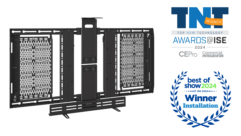JET Nightclub Takes Off With AV
After losing the Siegfried & Roy show, the Mirage Hotel in Las Vegas bounces back with a $17 million nightclub complete with custom AV.
The main dance floor in the Mirage Hotel and Casino’s JET nightclub in Las Vegas features a unique video ceiling comprised of 120 2- by 2-foot Traxon Technologies Tile 64PXL LED panels that produce a grand total of 23,000 pixels across the vast ceiling.
Credit: Courtesy of Dana Anderson of Allen Photo Diversified
CHALLENGE: Design a one-of-a-kind LED ceiling array for a Las Vegas nightclub to compensate for design elements eliminated by a low ceiling.
SOLUTION: Work with manufacturers to tailor the ceiling panels and control system.
IN 2003, the Mirage Hotel and Casino suffered a major setback with the permanent closure of the Siegfried & Roy show, a perennial favorite on the Strip. Since then, the Mirage has staged a quiet renovation of both its building and its image. As one of the original destination resorts, the hotel has recently added several new entertainment spots to regain its foothold in Vegas nightlife.
DMX LIGHTING CONTROL STANDARD
A rarity in AV, DMX lighting control is a standard lighting control language and a form of RS485 architecture. DMX was originally intended for use in linking controllers and dimmers from different manufacturers — a protocol to be used as a last choice after trying other proprietary methods. However, it soon became the primary method for not only linking controllers and dimmers, but also linking more advanced fixtures and special effects devices such as foggers.
DMX has gained in popularity for several reasons:
- DMX512 is a method of connecting a single controlling source to multiple receivers.
- Serial data can be sent up to 4,000 feet over microphone-like cables.
- Up to 512 devices — or functions on a device — can be controlled with 8-bit resolution.
- All channels are continually being “refreshed,” which increases safety.
- Although the DMX512 standard has been updated, existing equipment still works the same under any new revision.
— Sources: Wikipedia; Pangolin Laser Systems (pangolin.com)
JET, the $17 million nightclub owned by the Mirage and operated by the Light Group, opened for business in January 2005 and instantly became one of the hottest clubs in town. Built in the space of 150 former accounting offices within the hotel, JET’s 15,000-square-foot footprint packs a great amount of AV into a modest amount of space.
JET’s interior was conceived by renowned designer Jeffrey Beers of design firm Jeffrey Beers International. To match the high-profile décor with state-of-the-art AV technology, Light Group brought in John Lyons, president of design-build company John Lyons Systems and owner of the Avalon clubs in Boston and New York, as well as the Avalon and Spider Club in Los Angeles.
With an AV budget of approximately $750,000, Lyons needed to install cutting-edge entertainment technology in each of JET’s three distinct rooms, which feature hip hop, rock, and house music. To do so, he worked with several manufacturers to customize their products to best fit JET’s needs.
Custom audio
As a long-time development partner with EAW for its Avalon loudspeaker line, Lyons again sought the help of the company’s engineering and product development teams for this project. “I needed a hybrid loudspeaker, with the high output of an Avalon DC1 and the smaller size of an Avalon DC2,” he says. “The result was a custom, high-energy, compact enclosure that really blows you away.”
The team created the Avalon DCX loudspeaker, a custom product that incorporates EAW’s AX series CSA technology and elements from the Avalon Series club loudspeakers. The guts of the DCX is comprised of the mid-high section of the EAW AX396 with two 12-inch woofers mounted on each side and with two of the bullet tweeters in the Avalon DCT1 tweeter array integrated into the mix.
HYPERCARDIOID COVERAGE PATTERN OF SUBWOOFERS
Predictions of subwoofer array response: Final response (shown here) after DSP processing showing 10 dB attenuation at +- 90 degrees off axis.
To tune the unique sound system at the JET nightclub at the Mirage Hotel and Casino in Las Vegas, John Lyons, president of design-build company John Lyons Systems, made special arrangements with Rich Frembes and Jamie Anderson of EAW’s product development team. Prior to traveling to Vegas, the duo had a specific challenge to address: how to limit the low-frequency spillage from the sub arrays on the 34- by 50-foot dance floor onto the 10-foot bar areas on each side. At the factory, Frembes created an acoustic model of the two Avalon DCS2 sub arrays using EAW’s proprietary software called FChart, created by EAW’s VP of Research and Development Dave Gunness.
FChart goes several steps beyond current modeling programs, allowing for modeling of low frequencies (25 Hz to 126 Hz) beyond a point source model. The program also allows the user to see how loudspeakers or subs radiate into a specific space.
The geometry of the dance floor (low ceiling and rectangular space) meant that the subs needed to be installed in a linear fashion rather than a traditional cube formation. Each 12-foot-wide sub array faces each other from the long ends of the dance floor. “The typical solution is to apply a physical or DSP delay to the cluster to address phase cancellations,” Frembes says. “In this case, we also looked at the layout in AutoCAD, took into account where people would congregate, and decided the amount of energy we wanted to direct and where.”
The next step was to invert the polarity of the far sub array (opposite the DJ booth), and use the delay and EQ available on the installed Crown I-Tech amplifiers to push the null space off to the sides of the room. The end-result was an approximately 10 dB reduction in low-frequency energy from the dance floor to the bar area.
To go the extra mile, EAW also created a new enclosure shape as well as a custom billeted grille design, completely purpose-built for JET. The enclosure was wider and had a lower profile than others in the Avalon Series, so the DCX would blend into the club’s architecture. In the main hip hop room, six DCX loudspeakers are installed along each side of the dance floor. Overhead, two banks of four EAW Avalon DCS2 sub-woofers built into soffits provide low end coverage to the dance floor. To help contain the low-end energy and minimize the spillover from the dance floor into other areas of the club, the subwoofers were tuned to create a hypercardioid sub array pattern, using the onboard processing capability of the 14 Crown I-Tech 4000 and 6000 amplifiers.
Lyons also worked with the EAW team to develop another custom loudspeaker — the JL12 12-inch coax ceiling speaker. Thirty-six of the JL12 ceiling speakers are used in the main room’s bar areas and as the main PA in JET’s other two rooms. Thirty-four EAW CIS 400 8-inch ceiling speakers assist with sound coverage. “The use of ceiling speakers complemented the club’s clean and modern appearance,” Lyons says. “Additionally, the JL12s are also powerful enough to keep up with the dance floor system.”
JET also includes another technology first: It’s the first installation to use the new Mackie d.2 DJ mixer.
Custom application
Andy Masi and Sean Christie, managing partners for the Light Group, gave Lyons complete creative license for the lighting as well as the sound. From the lighting perspective, it initially seemed that Lyons would be hampered by the club’s relatively low 15-foot ceilings. A ceiling of that height usually means eliminating some options like moving lighting structures and reducing the amount of long-throw fixtures.
This challenge led to some unconventional brainstorming and a new vision for the ceiling itself. In addition to conventional club lighting using Martin fixtures, Lyons designed and installed a $150,000 video ceiling comprised of 120 LED panels over the main dance floor. “My vision was a permanently installed ceiling that could play video as well as handle a light show,” he says. “I had originally fabricated my own LED panels, but they couldn’t function quite the way I wanted.”
Each of JET’s three distinct rooms, which feature hip hop, rock, and house music, pack a great amount of AV into a modest amount of space.
Credit: Dana Anderson of Allen Photo Diversified
Richard Worboys, head lighting designer for all of the Avalon clubs and two-time winner of the UK Light Jockey competition, also collaborated with Lyons on the lighting design for JET. While attending the PLASA trade show, Worboys discovered LED panels by Traxon Technologies and got the two parties in touch. Traxon’s 2- by 2-foot square Tile 64PXL panels feature 64 nodes of RGB for a total of 192 nodes per panel, producing a grand total of 23,000 pixels across the ceiling.
Working on a tight deadline of just six weeks, Traxon provided the 120 panels in enough time for Lyons to conduct slight rigging modifications. Originally developed for low-voltage commercial signage and residential mood lighting, the Traxon Tile 64 product is designed to hang like a louver via grommets on the back of the panel. At JET, these panels had to be flush-mounted to the ceiling. Lyons designed custom rigging for each panel so it could hang on the club’s installed pipe rails.
With the panels in place, the next challenge was to develop and install a control system that could communicate with the ceiling as one entity. “We needed 60 universes of DMX lighting control, which really pushes the limit of most control products available today,” Lyons says. “Traxon connected us with a control platform company in Germany that can talk to that many universes.”
DMX or DMX512, an acronym for Digital MultipleX, is a standardized lighting communications protocol used to control stage lighting (see sidebar on page 16). A relatively young technology, DMX was created by the Engineering Commission of the United States Institute for Theatre Technology (USITT) in 1986. After several iterations, the American National Standards Institute (ANSI) approved the current version of DMX (with a long-form name of E1.11, USITT DMX512–A) in 2004.
FOR MORE INFORMATION
- American DJwww.americandj.com
- Crownwww.crownaudio.com
- EAWwww.eaw.com
- e:cuewww.ecue.tv
- Green Hippowww.green-hippo.com
- High End Systemswww.highend.com
- Kramerwww.kramerelectronics.com
- Mackiewww.mackie.com
- Martinwww.martin.com
- ShowCADwww.showcad.com
- Traxonwww.traxon-usa.com
Lyons worked with Paderborn, Germany-based control platform company e:cue, which manufactures a 1U rack-mount CS-1 server that runs its e:cue programmer software on a Microsoft Windows XP operating system. Coupled with show control software ShowCAD Artist, the CS-1 server completes a powerful control system that produces a stunning light show at JET. “With 23,000 pixels, the ceiling’s capabilities are endless,” Lyons says. “It plays video beautifully and the light show is incredible. We’re also working toward a solution to make each pixel individually addressable.”
The ceiling can also function as a single giant display using two Green Hippo Hippotizer media servers with video switching handled by a Kramer VP-8×8 matrix switcher. For greater flexibility, Lyons also installed six High End Systems Catalyst DL1 automated lighting and video projectors. The DL1 functions like a moving light, but with digital video projector capabilities that adds another layer into the lighting design. Using the DL1s, laser effects, images, or video can be projected onto the ceiling or the walls for added effect.
Rounding out the lighting rig, Lyons also specified and installed an array of Martin lighting. The main room features 16 Martin Mac 250 Krypton Luminaires, eight Martin Mac 550 spots, 16 Martin Atomic 3000 strobes, and 36 American DJ Accuscan 250 scanners.
Linda Seid Frembes is a freelance writer and PR specialist for the professional AV industry. She can be reached at [email protected].










